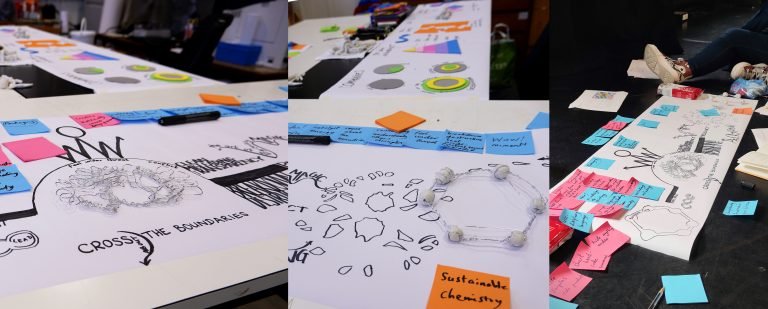2-Day workshop
In our second event we invited selected Designers and Chemists for a 2-day workshop at ASCUS lab in Edinburgh.
Midst the buzz of Summerhall, a creative venue for arts, design and science, a group of participants had travelled from across the UK and beyond for the immersive workshop: Molecular Architectures: towards cross-disciplinary Design in Chemistry.
How does creativity connect design and science? What are the similarities between science and design language, methods and processes, and how can these disciplines learn from each other?
Guided by these questions, we started the workshop with an icebreaker to get to know the group, what drives them and how they view the world.
Cross-Disciplinarity through diversity
Diving into cross-disciplinary explorations, the diverse group of Molecular Chemists, Medicinal Chemists, Microbiologists, Biodesigners, Fashion Designers, Experience Designers and Virtual Reality Artists was invited to undertake a range of chemistry experiments. Paired up in teams of a scientist and a designer/artist, they followed the protocols/recipes and poured and heated and stirred, resulting in often surprising changes in colour, consistency and volume.
Cross-disciplinary language and the process of making
To bring the diverse disciplines together, finding ways to understand each other was our starting point. We asked: How did you experience the process and making from your perspective? Was there terminology in the protocol that was new to you? How would you the material transformation?
In this exercise each team member talked through the experiment, the steps and their perceptions of the experience. These narratives were supported by media of their choice in order to find the best way to tell their perspective to the team partner.
“The language exercises really elevated the experience of the experiment and brought such excitement”
As a first step to facilitate discussions around language of the disciplines and the potential for a shared language through diverse media, each team was supported to build a basis for their collaborative work on day 2.
Sustainable Chemistry and Design Processes
Day 2 of the workshop started with a recap and the introduction of 3 challenges the teams from Day 1 were invited to tackle with help from our ASCUS team and Amanda.
Before going off in their groups, we invited Amanda to share of Design principles in Molecular Chemistry and Sustainable Chemistry within the Circular Economy, introducing sustainability as a common term and interest between disciplines.
The fabulous multi-disciplinary teams merged into larger groups and in unique approaches to each discipline, the teams took diverse media, such as graphics, clay and foam to create responses to the challenges.
Supported by the facilitators Amanda and Paula and the lab manager Keira, the participants were invited to explore their challenges by using design tools, such as Sustainable Design Cards or do a range of further experiments. Some with focus on sustainability, others looking at colour and light as inspiration point. One never knows when inspiration hits you and why not have some fun on the way :)
How do we see design and what are the processes in our own discipline? Where are the overlays of these in the fields of Fashion, Architecture and Molecular Chemistry? Through exchange and brainstorming, many similarities were found... and also very different ways of approaching a challenge :) How often do we have the opportunity to get together and take time to share, and step into how another person and other disciplines see the world? And how do we break down the barriers between disciplines in a world that drives more and more towards interdisciplinarity?
“The barriers of not ‘knowing’ everything didn’t matter, it was more about sharing skills - and enthusiasm, created opportunities for conversations and potential link ups.”
Looking at getting the magic of cross-disciplinarity to drive projects, another team started off with revisiting their sculptural piece from day 1 and finding inspiration within the shared language, guiding them into the values being cross-disciplinarity for new systems thinking. Placing their project within a context of sustainable goals and human centred research the team used their project to reflecting on how and where to start conversations with people from other disciplines to create a holistic view of the impact and value as well as future process of their projects.
Looking at getting the magic of cross-disciplinarity to drive projects, another team started off with revisiting their sculptural piece from day 1 and finding inspiration within the shared language, guiding them into the values being cross-disciplinarity for new systems thinking. Placing their project within a context of sustainable goals and human centred research the team used their project to reflecting on how and where to start conversations with people from other disciplines to create a holistic view of the impact and value as well as future process of their projects.
“Science and art are much more inter-connected than I expected, that through mutual collaboration we can constantly keep learning and achieve great results”
And we at ASCUS learned so much from all participants! We are still so excited about the open exchange and the new viewpoints and possibilities that we and all participants got to experience. Thank you everyone who joined and we look forward to follow your journey :) See you again soon!
Stay tuned for Phase three of this project coming in 2023.










